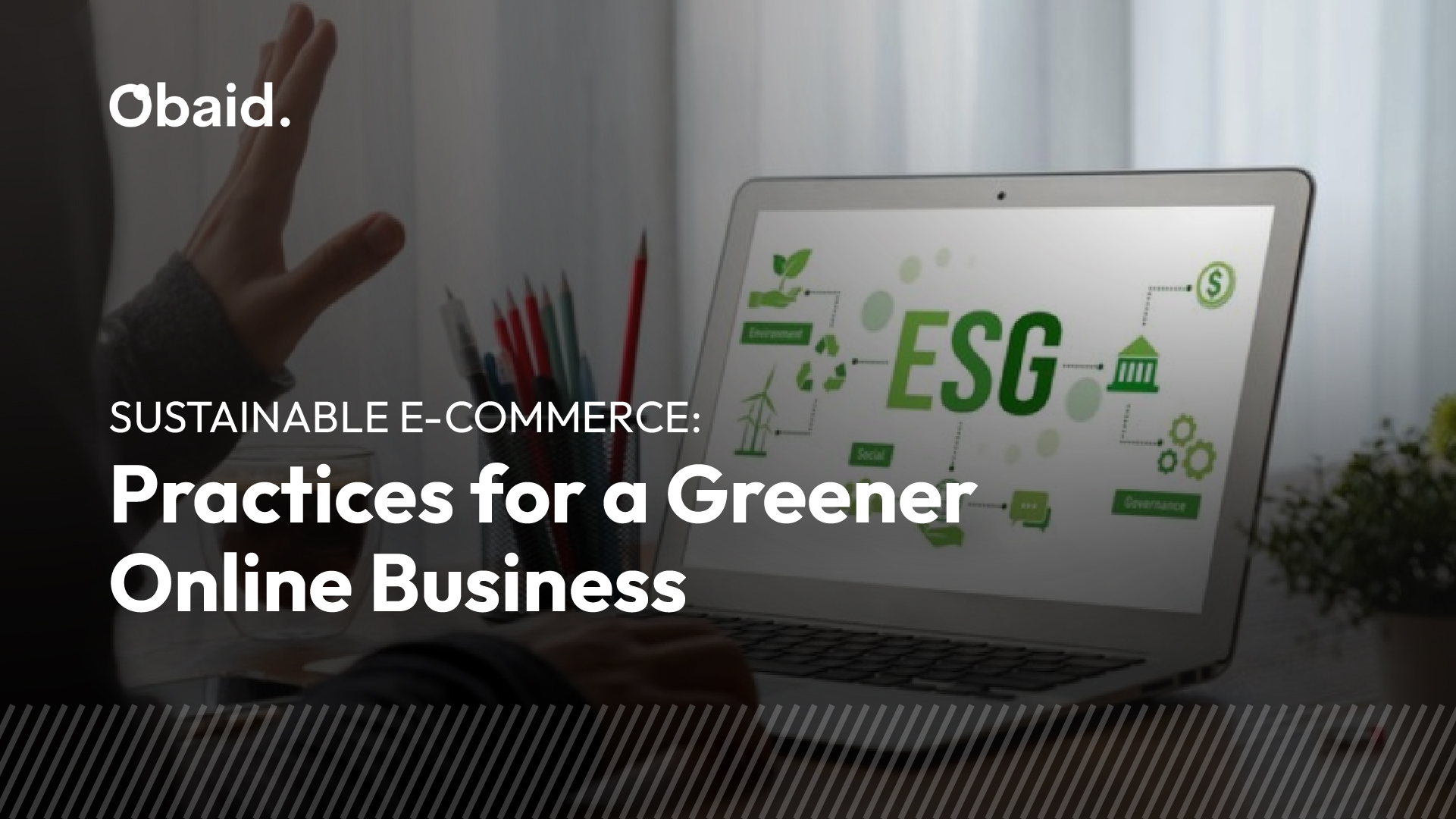Sustainable E-commerce: Practices for a Greener Online Business
Published on July 15, 2025

Highlight eco-friendly strategies that e-commerce businesses can adopt to appeal to environmentally conscious consumers.
The E-commerce industry is where customers place orders online, and brands secure products in safe packaging and ship them to the customer. The package may ship back to the brand if the customer is not satisfied with the product for any reason. Although e-commerce has made shopping easier, it also has a growing impact on the environment. Paper or plastic packaging waste and the carbon produced due to fuel combustion while shipping are somehow affecting our environment.
Canopy, a group working for forest conservation, reported that around 3 billion trees are cut down every year to manufacture 241 million tons of cartons for shipping purposes. On the other hand, plastic packaging is produced in huge amounts i.e., 86 million tons and its recycling percentage is not even 14. The contribution to greenhouse gas emissions due to shipping and return shipping is approximately 37% of the total amount of GHG produced by other means.
On one hand, e-commerce brings us the most convenient way of shopping as we can shop without taking out time and burning fuel. On the other hand, the waste produced and the shipping fuel combustion have also added to the planet’s pollution. That’s why it’s so important for online businesses to start making eco-friendly choices. So, here we gathered some solutions brands can practice for a greener online business.
1. Eco-Friendly Packagin
In online shopping, products need to be packed securely, for which brands use plastic wraps, bubble wraps for more delicate products, and oversized boxes for secure delivery. This produces a lot of waste, and landfills also pollute oceans. Changing the way brands pack their products can bring a prominent difference in lowering pollution. You can:
- Use eco-friendly materials i.e., packaging made from recyclable, biodegradable, or compostable materials. For example, paper mailers, cardboard boxes, and corn-starch-based packing peanuts are better for the environment than plastic.
- Pack products in the right size box so more packages can be loaded in a vehicle at a time. This will reduce waste, cut down shipping costs, and also reduce carbon emissions into the air.
- Encourage customers to recycle packaging by adding a message or symbol on the box. You can also include tips on how they can reuse the materials at home.
A famous fashion brand in Pakistan, “Sapphire,” took an important step to take part in sustainable e-commerce. Launched originally in 2018 for Independence Day, these biodegradable bags were infused with seeds that customers could tear up, plant, and grow trees. The campaign was hugely popular. Then again Sapphire introduced reusable canvas tote bags crafted from their leftover fabric. These sturdy bags hold up to 3 kg and were given out in stores like Lahore’s Ramadan Bazaars, replacing single-use plastic bags.
2. Offset Carbon Emissions
Every time a product is shipped, it creates carbon emissions, whether it’s from the warehouse, trucks, or planes. These emissions harm the environment and add to climate change. That’s why online businesses need to find ways to reduce or offset this impact.
One simple option is to offer carbon-neutral shipping at checkout. This means the store pays a small amount to support eco-friendly projects, like planting trees or funding clean energy, to balance out the emissions from delivery. Businesses can also partner with carbon offset programs, which calculate and remove the carbon created by each order. Another way to help is by using local fulfillment centers to deliver orders faster and over shorter distances, which reduces fuel use and pollution.
2. Offset Carbon Emissions
Every time a product is shipped, it creates carbon emissions, whether it’s from the warehouse, trucks, or planes. These emissions harm the environment and add to climate change. That’s why online businesses need to find ways to reduce or offset this impact.
One simple option is to offer carbon-neutral shipping at checkout. This means the store pays a small amount to support eco-friendly projects, like planting trees or funding clean energy, to balance out the emissions from delivery. Businesses can also partner with carbon offset programs, which calculate and remove the carbon created by each order. Another way to help is by using local fulfillment centers to deliver orders faster and over shorter distances, which reduces fuel use and pollution.
3. Promote Circular Commerce
Many products are used once and thrown away, which creates a lot of waste. Circular commerce is a smarter way of doing business. It encourages reusing, repairing, and recycling instead of discarding. This helps protect the environment and builds trust with customers who care about sustainability.
E-commerce brands can take part by starting buy-back or trade-in programs, where customers return old items for store credit. Businesses can also sell refurbished or pre-loved products at lower prices, or offer repair services and spare parts to extend the life of their items.
H & M, a multinational retail clothing company, runs a Garment Collecting Program, both in stores and online. Customers can return used clothes from any brand, in any condition. H&M either recycles the materials or reuses them to create new products. In return, customers often get a discount voucher. This not only reduces textile waste but also encourages more responsible shopping.
4. Greener Shipping Solutions
Fast shipping is great, but it often causes more pollution because it needs more transport trips and uses more fuel. That’s why it’s important to offer greener ways to deliver products. Here are some ways:
- One way is to give customers an eco-delivery option at checkout for orders that aren’t urgent. This allows the company to group shipments and plan routes better, reducing the number of trips.
- You can also encourage customers to get everything in one package, instead of sending multiple boxes.
- Another smart step is to partner with courier services that use electric or hybrid vehicles, which produce less carbon pollution.
- Add a clear label at checkout saying, “Choose Green Shipping.” Many people will go for it if they know it helps the planet.
5. Go Paperless
Paperwork creates too much paper waste, so switch to digital communication where possible. This way, brands can:
- Reduce waste,
- Save money,
- Work more efficiently.
Instead of giving printed receipts, send receipts to your customers through email or SMS. You can also share product manuals and user guides online instead of printing them. Inside the company, use cloud-based tools to store documents, invoices, and records.
6. Build a Sustainable Supply Chain
Being truly eco-friendly means thinking about where your products come from, even before they reach your warehouse. A sustainable supply chain starts with choosing the right suppliers. Work with those who use eco-friendly materials and follow fair labor practices. Make sure the materials you use, like organic cotton or recycled fabrics, are kind to the planet and people.
7. Use Renewable Energy
The energy your business uses, whether in offices, warehouses, or websites affects the environment. You can lower your carbon footprint in the following ways:
- Switch to renewable energy
- Choose a web hosting provider that runs on green energy.
- Install solar panels in offices and warehouses
- Use energy-saving lights and appliances to cut down electricity use and save money.
8. Educate Your Customers
Not all customers know how to be careful about sustainability while shopping. A brand can educate them on the importance of sustainability by telling them about the steps the brand is taking for the environment, like using eco-friendly packaging or sustainable materials through your website, social media, and even on your product tags.
You can also share tips on how to recycle your packaging, care for products to make them last longer, or return used items. Brands like Sapphire and Generation in Pakistan are already doing a great job by talking about sustainability and slow fashion. When you educate your customers, you help them make better choices and build stronger trust with your brand.
9. Be Transparent
Being honest about your sustainability efforts is very important. Many brands lose customer trust by pretending to be eco-friendly without making real changes; this is called greenwashing. To avoid this, share your eco goals clearly, even if you’re just starting.
Show proof of what you’re doing, like using certified materials (FSC, Fair Trade, etc.), and mention any partnerships with trusted programs. Also, be open about what you’re still working on. A great way to build trust is by adding a “Sustainability” page on your website where you regularly update your progress. This way, your customers know you’re serious and real about going green.
10. Sell Eco-Friendly Products
Selling eco-friendly products is a smart way to attract customers who care about the environment. Today, many shoppers prefer items that are good for the planet. That means offering products made from organic, recycled, or reused materials can help your brand stand out. You can also use less packaging or offer reusable packaging options. And if possible, promote digital products like eBooks or online gift cards to avoid waste.
11. Measure and Improve
Measuring what you achieve after your eco-friendly efforts is essential. It will help to improve more and more. Start by keeping a record of your energy use, packaging waste, and delivery emissions. Use tools like EcoCart or Carbon Analytics to check how much carbon your business is producing. Once you have the numbers, set clear goals to reduce them and review those goals often. Share your progress with your customers. It makes them feel part of your green journey and builds trust in your brand.
Final thoughts
People are conscious about their environment, and going green is essential to attract customers who prefer to purchase from brands that support sustainable e-commerce. So, develop new ideas and find ways to develop a greener online business.

Obaid Arshad
CEO & Co-Founder
